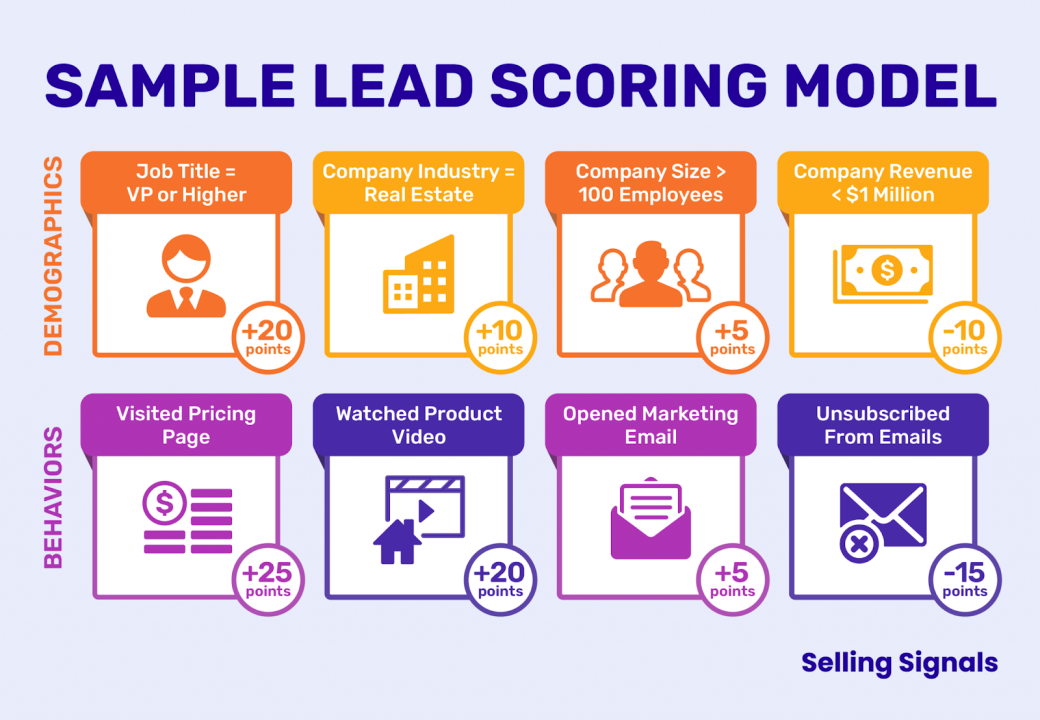AI-Powered Lead Scoring: How AI Helps Identify High-Intent Users

AI-Powered Lead Scoring: How AI Helps Identify High-Intent Users
Lead generation is an essential component in any effective marketing strategy. However, there are many pitfalls that marketing teams face. This article shows how AI can improve the effectiveness of lead scoring and eliminate unnecessary errors and inconsistencies.
Traditional lead scoring methods see businesses use a rule-based system to rank the quality of their leads so that sales and marketing teams can focus on the most high-intent leads and identify where they are in the buying process.
With a traditional lead scoring approach, points are assigned to customers and subscribers (leads) based on predetermined demographic factors (age, gender, location, and income) and behaviors, social media interactions, and conversations with the sales team about their intent for a product or service.

Traditional lead scoring is brilliant when approached correctly, but without implementing the best frameworks for ranking your customers, you could run into some challenges as a business.
Let’s take a closer look at some of the challenges preventing your marketing team from getting the most out of their leads:
- Human error: Any lead generation strategy that relies on manual input is open to human error. Whether this is inputting incorrect contact information or misaligning email campaigns, it can be tricky to manage a manual lead generation process, especially when teams must look through a mass of data from website traffic and social interactions.
- Fostering the wrong leads: Did you know that not all leads are valuable for your business? Many sales and marketing teams spend too long nurturing poor-quality leads and miss high-intent leads due to a lack of data.
- Lack of real-time insights: Traditional lead scoring strategies neglect to provide those all-important real-time insights. This makes it twice as hard to spot changing patterns in customer behaviour as the market shifts.
- Wasted time and resources: Don’t waste time and resources on leads you’re unsure will convert. Sales and marketing teams often spend valuable time on targeting leads that are unlikely to convert, missing potential customers in the process.
These challenges are all solvable; they just require time, effort, and a little help from AI-powered tools.
Advanced technologies such as machine learning and natural language models are just a few of the lead generation aids we’ll mention in this article.
Stick with us as we teach you how to use AI tools to rank your leads efficiently and showcase AI’s benefits for identifying high-intent users.
What Is AI-Powered Lead Scoring?
Let’s start by explaining AI-powered lead scoring. This advanced and modern approach to lead generation relieves the pressure on your SEO team.
Using AI, Leads are ranked in order of how likely they are to result in a desired conversion (buy a product or service, sign up for a subscription, or fill out a contact form) using real-time and even your historical data.
Using AI in e-commerce lead scoring ensures your sales and marketing teams prioritize their time, money, and resources on high-intent leads. These are the customers who are most likely to convert, generate store revenue, and contribute to your business growth.
Benefits Of AI-Powered Lead Scoring
- Minimized Human Errors
- Better Sales & Marketing Relationships
- Data-driven Decision Making
- Integration with CRM platforms
- Improved Conversion Rates
Minimized Human Errors
A traditional lead-scoring approach relies on qualitative data and human judgment. As mentioned above, this can lead to inconsistencies and human errors, especially when your sales and marketing teams are under pressure, tired, or have an emotional bias.
Meanwhile, AI-powered lead scoring relies on objective, data-driven criteria, which minimizes human error. In addition, AI employs speech analytics, eliminating any human errors caused when scoring leads on sales and marketing calls.
Accurate lead scoring ensures your business doesn't overlook any high-intent leads or focus on the wrong customers.
Better Sales & Marketing Relationships
With a shared, AI-powered lead scoring system and data-driven rankings, sales and marketing teams will easily agree on which leads are worth targeting. This improves team collaboration and eliminates disagreements over lead quality.

Better relationships between your sales and marketing teams improve the overall efficiency of lead nurturing, lead to more successful lead targeting outcomes, and ensure a friendly workplace environment.
Data-driven Decision Making
Traditional lead-scoring methods involve sales and marketing teams ranking their leads based on human judgment and an overload of qualitative data. In comparison, AI examines vast datasets to better understand customer demographics and behaviors, such as purchase history and engagement patterns.
AI bots then use this accurate, real-time data to get a clear picture of your leads and make ranking decisions accordingly, before handing a ranking list to your sales or marketing teams.
Integration with CRM platforms
Many AI-powered lead scoring tools can be integrated with your customer relationship management (CRM) system. This eliminates the need to toggle between multiple platforms to access critical lead data, maximizing efficiency and accuracy.
For example, in a single platform, sales and marketing teams can view real-time rankings, see a lead's behavioral history, and receive personalized recommendations on targeting them.
Integrating your AI lead scoring data with your CRM system will ensure that no high-intent leads are missed or overlooked, which commonly happens with a traditional lead scoring approach.
In addition, ensure your marketing automation platforms are also integrated with your AI-powered lead-scoring tool so that behavioral data is also factored into the rankings.
Improved Conversion Rates
Last but certainly not least, AI-powered lead scoring improves your conversion rates. This is because the primary goal of AI-powered lead scoring is to improve the accuracy of lead identification.
By targeting and engaging with the most valuable leads at the right time, they are more likely to take your desired action (convert).
Increased conversion rates, alongside lower overhead costs and better resource management, will likely result in revenue growth for your business.
How AI-Powered Lead Scoring Helps Identify High-Intent Users
Generating leads (through email marketing, customer referrals, social media, or more) is only the first step. The real challenge is identifying high-intent leads - those actively looking to make a purchase or take a specific action (conversion).
Here is a step-by-step guide on how AI-powered lead-scoring tools can help identify high-intent users:
- Data Collection
- Data Cleaning
- Data Training
1. Data Collection
AI-powered lead scoring starts with collecting data from various data sources, including your CRM system, marketing automation tools, online transactions, email campaigns, social media, website interactions, and other customer touchpoints.
The data that is collected from these sources includes:
- Demographic data. Who a customer is, such as their age, gender, job title, income, geographical location, marital status, education level, ethnicity, and language.
- Behavioral data. This aims to understand what customers do, such as visiting a website, downloading content, searching for queries, opening an app, and purchasing products or services.
- Engagement data. How customers connect with a brand, such as how they interact with social media content (likes, comments, or shares), how long they stay on a brand's website, whether they open a brand's email, whether they ignore or open push notifications, and whether they are part of a loyalty or reward program.
The data that is collected from the sources above is then processed for further analysis.
2. Data Cleaning
Once all of the above data is collected, AI systems clean it to remove inconsistencies, duplicates, and errors.
At this stage, AI systems also perform feature engineering, where new features are created by transforming existing data. For example, raw data such as 'time spent on the website' can be transformed into an actionable metric such as 'lead engagement score'.
3. Data Training
Machine learning algorithms learn the characteristics of leads that converted into customers and the characteristics of those that did not. This historical data from past leads is used to train the AI models.
The data training process includes the following:
- Identifying patterns. The machine learning algorithm identifies data patterns that correlate with successful conversions. For example, those who open a brand's emails frequently are more likely to make a purchase.
- Weighting factors. AI assigns weights to different characteristics based on the likelihood that they contribute to conversions. For example, frequent app visits might be assigned more weight than demographic information.
Once the AI system is trained, it assigns scores (typically between 0 and 100) to new leads based on their likeness to past successful leads.
What's Next For AI-Powered Lead Scoring?
Even after all steps have been completed and a ranking of leads is in place, AI-powered lead-scoring systems must continuously learn from new data. As more leads enter the system, the system must adjust the rankings, putting the new lead above or below other leads based on their likelihood to convert. This will help sales and marketing teams continuously prioritize the most high-intent leads.